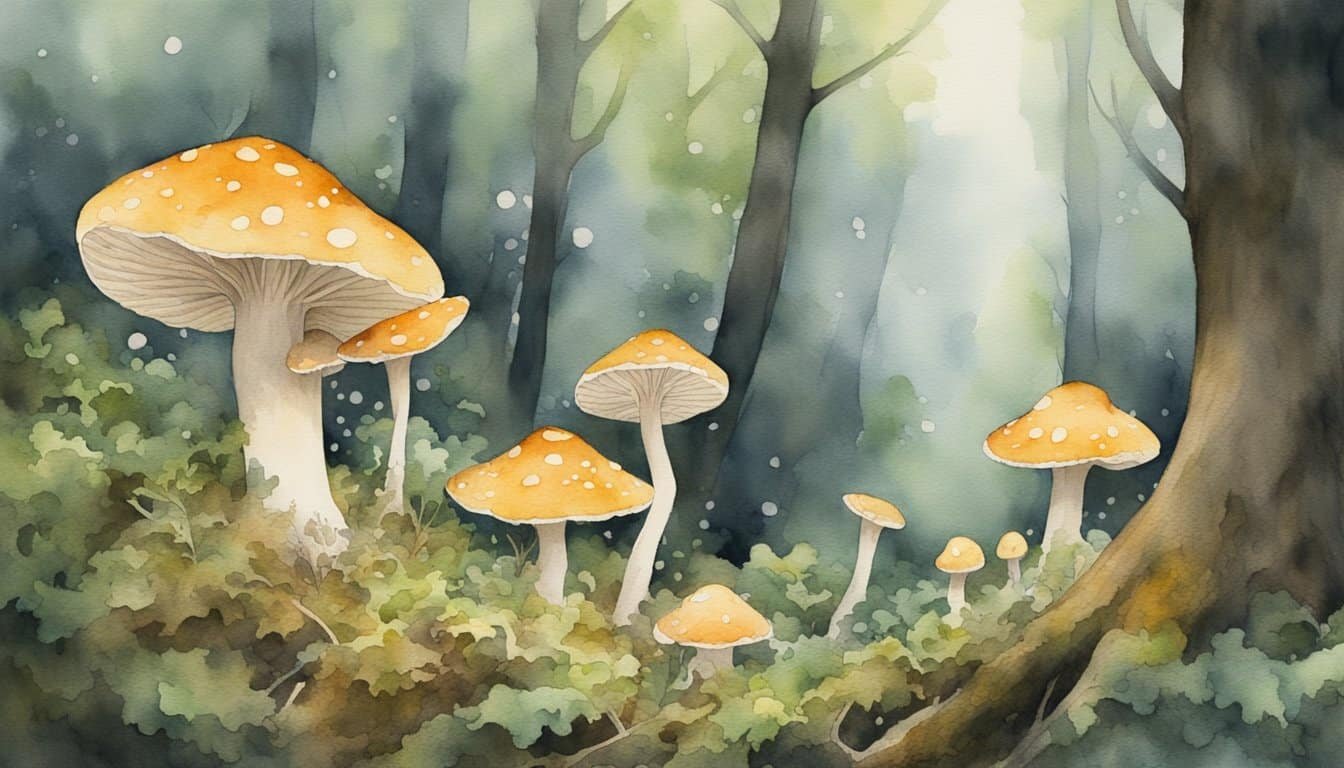Understanding Armillaria Ostoyae
Armillaria ostoyae, commonly known as the honey mushroom, is a fascinating species that plays a dual role as a decomposer and a pathogen in forest ecosystems. With a lifecycle and impact as complex as its vast underground network, this fungus presents a rich topic for exploration.
Biology and Lifecycle
Armillaria ostoyae is a species of fungus in the genus Armillaria, belonging to the order Agaricales. It leads a mostly hidden life as mycelium, a network of thread-like cells, through soil and wood. The fungus is renowned for its ability to form rhizomorphs, which are root-like structures. These rhizomorphs allow the fungus to transport nutrients and increase the organism’s reach within forest soils.
The reproductive phase of Armillaria ostoyae involves the production of spores within gilled mushrooms that emerge from the ground, typically near the base of trees. These fruiting bodies are recognizable by their honey-colored cap along with the presence of gills and a central stipe extending downwards. After release, the spores germinate to create new mycelial growth, continuing the lifecycle.
Significance of Armillaria Ostoyae
Named by Charles Horton Peck, this species has been studied by the Nomenclature Committee for Fungi due to its ecological impact and remarkable physiology. In North America, particularly in the Pacific Northwest and regions like the Malheur National Forest in Oregon, Armillaria ostoyae has gained notoriety as the “Humongous Fungus,” competing for the title of the world’s largest organism with contenders like the blue whale, the seagrass Posidonia australis, and the aspen grove Pando in terms of area coverage and biomass.
This species causes decay and disease in hardwood forests, but it also carries out the beneficial task of breaking down dead wood. The bioluminescence phenomenon, also called “foxfire,” can sometimes be associated with these mushrooms, adding a mystical glow to the forest floor by night. Armillaria ostoyae’s diverse roles in its ecosystems, both harmful and helpful, make it a subject of continuous interest and study.
Armillaria Ostoyae and Its Hosts

Armillaria ostoyae is a formidable forest pathogen, often creating striking “fairy rings” in its wake and affecting a broad range of tree species with varying degrees of impact.
Symptoms and Diagnosis
Armillaria ostoyae infection can be identified by a number of symptoms, indicating a progressive and destructive interaction with its hosts. Trees, especially conifers like Douglas-fir and hardwoods such as aspen, exhibit signs such as reduced growth, yellowing foliage, and white fungal growths at the base. The diagnosis is often confirmed through the presence of black rhizomorphs (shoe-string like structures) on the root system or at the tree’s base. Additionally, decay in the form of butt rot can severely weaken the structural integrity of the tree. Insight into the epidemiology of the disease can be gleaned from the frequency of these symptoms.
Spread and Management
The spread of Armillaria root disease through a forest can be insidious as the pathogen progresses from diseased trees and stumps to healthy ones, moving through the soil and occasionally through mycelial cords underground. This spread is particularly notable in planting sites where diseased host material remains. Management strategies focus on reducing the inoculum by removing infected material and the use of resistant species in reforestation. Proactive measures also include harvesting methods designed to minimize soil disturbance and the creation of open wounds on trees, which can serve as entry points for the pathogen. Studies of the pathogen in British Columbia can provide a detailed perspective on the spread.
Culinary and Cultural Aspects

Armillaria ostoyae, commonly known as honey mushrooms, are a delightful treasure hidden within forested landscapes. It’s not just the taste but also the thrill of foraging that makes them a cherished entity in many cuisines and cultures globally.
In the realm of gastronomy, these fungi are notable for their firm texture and sweet, nutty flavor, which makes them versatile in various culinary uses. They can be sautéed, roasted, or stewed, and often feature in soups, risottos, and as accompaniments to meats, infusing dishes with their distinctive earthy essence.
Mushroom hunting, a cultural practice that involves searching for wild edible mushrooms like Armillaria ostoyae, is an autumnal activity enjoyed by many. It’s an intersection of cuisine and culture, where the forest becomes a pantry of natural delights. The process of finding and identifying these mushrooms is a skill passed through generations, deeply ingrained in the heritage of numerous communities.
Here’s a peek at how they might be enjoyed:
- Sautéed: Briefly cooked in butter or oil to retain their texture.
- Preserved: Pickled or dried for long-term storage.
- In Soups: Used to create a hearty, flavorful broth.
In various cultures, honey mushrooms hold more than just a spot on the dinner table; they represent a connection to nature and ancestral knowledge. They are quite literally intertwined with the regional identity and culture, featuring prominently in local feasts and traditional recipes.
While delicious and sought after, it’s crucial to forage with caution, as they can be easily mistaken for non-edible species. Always ensure mushrooms are properly identified before consuming, and when in doubt, consult a mycologist or an experienced forager.
Discover more about edible medicinal wild-growing fungi and how Armillaria ostoyae is utilized in various cultures.

